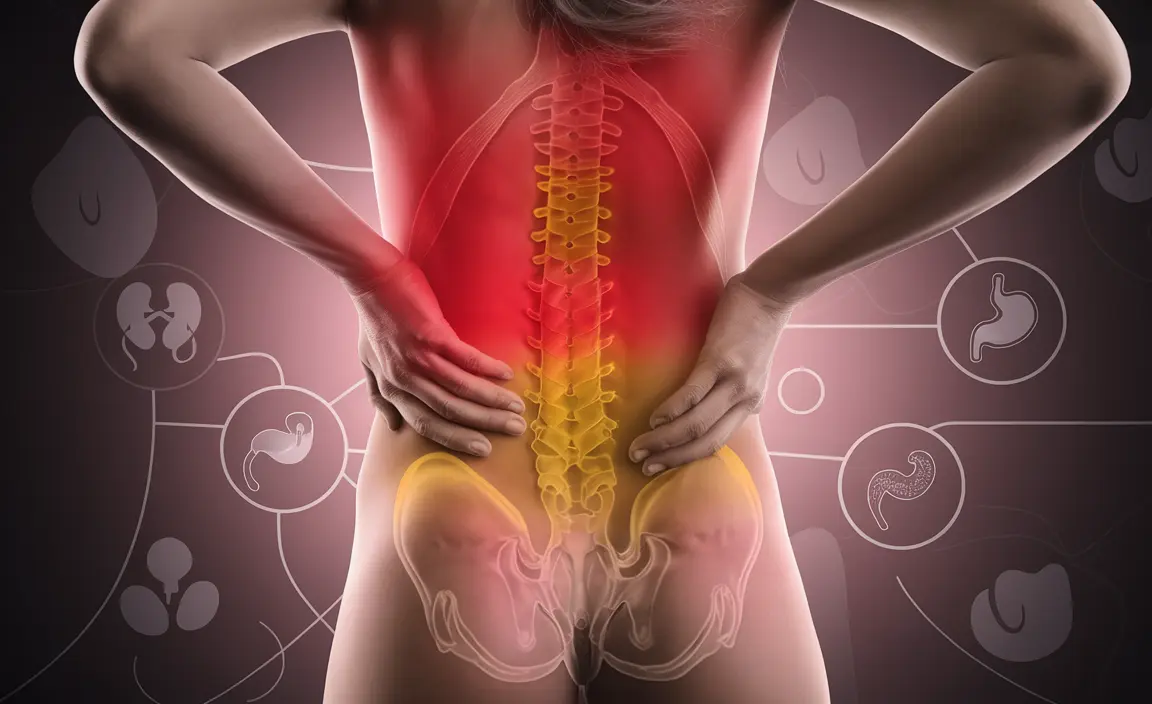Experiencing lower back pain and nausea simultaneously can be distressing for women, as these symptoms may signal various underlying health conditions that require attention. Understanding the connection between these symptoms and their potential causes is crucial for proper diagnosis and treatment.
This comprehensive guide explores the various conditions that can trigger both lower back pain and nausea in women, helping you identify when to seek medical attention and what treatment options are available.
Common Causes of Lower Back Pain and Nausea in Women
Several conditions can cause the simultaneous occurrence of lower back pain and nausea in women:
Gynecological Conditions
Many women experience these symptoms due to reproductive health issues:
- Endometriosis
- Ovarian cysts
- Pelvic inflammatory disease (PID)
- Menstrual disorders
- Ectopic pregnancy
Gastrointestinal Issues
Digestive system problems can manifest as both back pain and nausea:
- Gastroenteritis
- Inflammatory bowel disease
- Pancreatitis
- Appendicitis
- Food poisoning
Urinary System Problems
Kidney and bladder conditions often present with both symptoms:
- Kidney stones
- Urinary tract infections
- Kidney infections (pyelonephritis)
When to Seek Medical Attention
Certain warning signs indicate the need for immediate medical evaluation:
- Severe or worsening pain
- Persistent vomiting
- High fever
- Blood in urine or stool
- Difficulty urinating
- Unexplained weight loss
- Pregnancy symptoms
Diagnostic Process
Healthcare providers typically use several methods to determine the underlying cause:
- Physical examination
- Medical history review
- Blood and urine tests
- Imaging studies (ultrasound, CT scan, or MRI)
- Gynecological examination when appropriate
Treatment Approaches
Medical Interventions
Treatment options vary depending on the underlying cause:
- Prescription medications
- Anti-nausea drugs
- Pain management
- Antibiotics for infections
- Hormone therapy when appropriate
Self-Care Measures
Several home remedies can help manage symptoms:
- Heat therapy for back pain
- Gentle stretching exercises
- Proper hydration
- Rest when needed
- Over-the-counter pain relievers
Prevention Strategies
Taking preventive measures can help reduce the risk of recurring symptoms:
- Maintaining good posture
- Regular exercise
- Proper lifting techniques
- Healthy diet
- Stress management
- Regular health check-ups
Frequently Asked Questions
What are the common causes of lower back pain and nausea in women?
Common causes include gynecological conditions (such as endometriosis and menstrual disorders), gastrointestinal issues, kidney problems, and pregnancy-related changes. The combination of symptoms can also occur due to infections, inflammatory conditions, or stress-related issues.
When should I see a doctor if I have lower back pain and nausea together?
Seek immediate medical attention if you experience severe pain, persistent vomiting, high fever, blood in urine or stool, difficulty urinating, or unexplained weight loss. Additionally, if symptoms persist for more than a few days or interfere with daily activities, consult a healthcare provider.
How can kidney problems lead to both lower back pain and nausea in females?
Kidney problems, such as kidney stones or infections, can cause both symptoms because the kidneys are located in the lower back region. When infected or blocked, they can trigger pain that radiates to the lower back and cause nausea due to the body's inflammatory response.
Can menstrual or gynecological conditions cause lower back pain and nausea?
Yes, various gynecological conditions can cause both symptoms. Menstrual cramps, endometriosis, ovarian cysts, and pelvic inflammatory disease commonly present with both lower back pain and nausea due to hormonal changes and inflammation in the reproductive system.
What treatments are available for lower back pain and nausea caused by spinal or digestive issues in women?
Treatment options include prescription medications, physical therapy, anti-nausea medications, and lifestyle modifications. The specific treatment plan depends on the underlying cause and may involve a combination of medical interventions and self-care measures like heat therapy, gentle exercise, and dietary changes.




